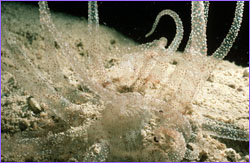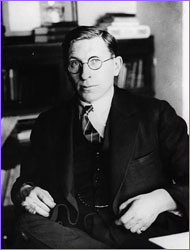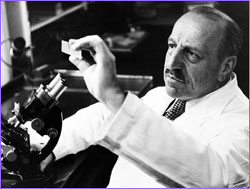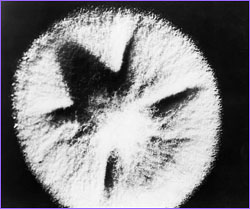 |
 |
|  Charles Robert Richet used poison from a sea anemone
like this one in his experiments on allergies.
Charles Robert Richet used poison from a sea anemone
like this one in his experiments on allergies.
|
Accidental Discoveries
Part 2 | Back to Part 1
Allergy
Charles Robert Richet, a French physiologist, made several experiments testing
the reaction of dogs exposed to poison from the tentacles of sea anemones. Some
of the dogs died from allergic shock, but others survived their reactions and
made full recoveries.
Weeks later, because the recovered dogs seemed completely normal, Richet wasted
no time in reusing them for more experiments. They were given another dose of
anemone poison, this time much smaller than before. The first time the dogs'
allergic symptoms, including vomiting, shock, loss of consciousness, and in
some cases death, had taken several days to fully develop. But this time the
dogs suffered such serious symptoms just minutes after Richet administered the
poison.
Though Richet was puzzled by what had happened, he realized he could not
disregard the unexpected result of his experiment. Later, he noted that his
eventual conclusions about the dogs' affliction were "not at all the result of
deep thinking, but of a simple observation, almost accidental; so that I have
had no other merit than that of not refusing to see the facts which presented
themselves before me, completely evident."
Richet's conclusions from his findings came to form the theoretical basis of
the medical study and treatment of allergies. He eventually proved that there
was a physiological state called anaphylaxis that was the antithesis of
prophylaxis: When an allergic subject is exposed to an allergen a second time,
he or she is even more sensitive to its effects than the first time. Instead of
building immunity to the substance through exposure (prophylaxis), the allergic
subject's immunity becomes greatly reduced.
In 1913 Richet received a Nobel Prize for his discovery and articulation of
diseases of allergy.
 Frederick Banting (above) and John MacLeod discovered
insulin, the elusive substance that regulates blood-sugar levels in the
body.
Frederick Banting (above) and John MacLeod discovered
insulin, the elusive substance that regulates blood-sugar levels in the
body.
|
|
Insulin
Frederick G. Banting, a young Canadian doctor, and Professor John J.R. MacLeod
of the University of Toronto shared a Nobel Prize in 1923 for their isolation
and clinical use of insulin against diabetes. Their work with insulin followed
from the chance discovery of the link between the pancreas and blood-sugar
levels by two other doctors on the other side of the Atlantic decades earlier.
In 1889, German physicians Joseph von Mering and Oscar Minkowski removed the
pancreas from a healthy dog in order to study the role of the pancreas in
digestion. Several days after the dog's pancreas was removed, the doctors
happened to notice a swarm of flies feeding on a puddle of the dog's urine. On
testing the urine to determine the cause of the flies' attraction, the doctors
realized that the dog was secreting sugar in its urine, a sign of diabetes.
Because the dog had been healthy prior to the surgery, the doctors knew that
they had created its diabetic condition by removing its pancreas and thus
understood for the first time the relationship between the pancreas and
diabetes.
With more tests, von Mering and Minkowski concluded that a healthy pancreas
must secrete a substance that controls the metabolism of sugar in the body.
Though many scientists tried in vain to isolate the particular substance
released by the pancreas after the Germans' accidental discovery, it was
Banting and MacLeod who established that the mysterious substance was insulin
and began to put it to use as the first truly valuable means of controlling
diabetes.
|  Dr. George N. Papanicolaou, who devised the "Pap"
smear test for cancer, examines a slide in his laboratory in 1958.
Dr. George N. Papanicolaou, who devised the "Pap"
smear test for cancer, examines a slide in his laboratory in 1958.
|
Pap smear
Dr. George Nicholas Papanicolaou's chance observation, while doing a genetic
study, of cancer cells on a slide containing a specimen from a woman's uterus
spawned the routine use of the so-called "Pap smear," a simple test that has
saved millions of women from the ravages of uterine cancer.
In 1923, Papanicolaou undertook a study of vaginal fluid in women, in hopes of
observing cellular changes over the course of a menstrual cycle. In female
guinea pigs, Papanicolaou had already noticed cell transformation and wanted to
corroborate the phenomenon in human females. It happened that one of
Papanicolaou's human subjects was suffering from uterine cancer.
Upon examination of a slide made from a smear of the patient's vaginal fluid,
Papanicolaou was astonished to discover that abnormal cancer cells could be
plainly observed under a microscope. "The first observation of cancer cells in
the smear of the uterine cervix," he later wrote, "gave me one of the greatest
thrills I ever experienced during my scientific career." Papanicolaou quickly
realized that doctors could administer a simple test to gather a sample of
vaginal fluid and test it for early signs of uterine and other cancers.
 Penicillium mold (enlarged here many times) is a
fungus that differs little from one that appears on bread in warm, humid
weather.
Penicillium mold (enlarged here many times) is a
fungus that differs little from one that appears on bread in warm, humid
weather.
|
|
Penicillin
The identification of penicillium mold by Dr. Alexander Fleming in 1928 is one
of the best-known stories of medical discovery, not only because of its
accidental nature, but also because penicillin has remained one of the most
important and useful drugs in our arsenal, and its discovery triggered
invaluable research into a range of other invaluable antibiotic drugs.
While researching the flu in the summer of 1928, Dr. Fleming noticed that some
mold had contaminated a flu culture in one of his petri dishes. Instead of
throwing out the ruined dish, he decided to examine the moldy sample more
closely.
Fleming had reaped the benefits of taking time to scrutinize contaminated
samples before. In 1922, Fleming had accidentally shed one of his own tears
into a bacteria sample and noticed that the spot where the tear had fallen was
free of the bacteria that grew all around it. This discovery peaked his
curiosity. After conducting some tests, he concluded that tears contain an
antibiotic-like enzyme that could stave off minor bacterial growth.
Six years later, the mold Fleming observed in his petri dish reminded him of
this first experience with a contaminated sample. The area surrounding the mold
growing in the dish was clear, which told Fleming that the mold was lethal to
the potent staphylococcus bacteria in the dish. Later he noted, "But for the
previous experience, I would have thrown the plate away, as many
bacteriologists have done before."
Instead, Fleming took the time to isolate the mold, eventually categorizing it
as belonging to the genus penicillium. After many tests, Fleming
realized that he had discovered a non-toxic antibiotic substance capable of
killing many of the bacteria that cause minor and severe infections in humans
and other animals. His work, which has saved countless lives, won him a Nobel
Prize in 1945.
Keep that mind open
For all you would-be Nobel Prize-winners, remember the one trait that tied all
these lucky strikers together: openmindedness. As the American physicist Joseph
Henry once noted, "The seeds of great discoveries are constantly floating
around us, but they only take root in minds well prepared to receive them."
Lexi Krock is editorial assistant of NOVA Online.
Photos: (1-7) Corbis Images.
Dr. Folkman Speaks |
Cancer Caught on Video
Designing Clinical Trials |
Accidental Discoveries |
How Cancer Grows
Help/Resources |
Transcript |
Site Map |
Cancer Warrior Home
Editor's Picks |
Previous Sites |
Join Us/E-mail |
TV/Web Schedule
About NOVA |
Teachers |
Site Map |
Shop |
Jobs |
Search |
To print
PBS Online |
NOVA Online |
WGBH
© | Updated March 2001
|
|
|